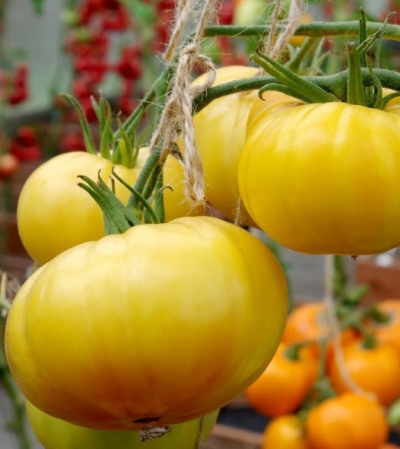
- Authors: Blokin-Mechtalin V.I.
- Year of approval: 2021
- Category: grade
- Growth type: indeterminate
- Appointment: fresh consumption, for juice
- Ripening period: mid-season
- Ripening time, days: 110-115
- Growing conditions: for film greenhouses
- Marketability: high
- Leaves: medium length, dark green
The word "cake" is associated with joy and happiness. But in order for Tomato Cream Cake to meet such expectations, you need to carefully read its features and take into account the main nuances. It is necessary to pay attention to the intricacies of cultivation and planting schemes.
Breeding history
Cream cake is practically the newest tomato. Its official registration as a crop admitted for practical cultivation was completed only in 2021. However, the developer of the plant is such an honored specialist as Blokin-Mechtalin. Therefore, there is no doubt about the quality of breeding work. And you need to pay attention to the real properties of the resulting plant.
Description of the variety
Tomato Cream cake belongs to the indeterminate group. The plant is positioned as suitable for a film greenhouse. Moderately long leaves develop on its bushes. They are characterized by a dark green color. Culture does not represent anything more unusual in botanical terms.
The main qualities of the fruit
This tomato is highly marketable. In an unripe state, its harvest, which develops on complex inflorescences, has a light green color. The spot in the region of the peduncle is not formed. When ripening, the fruits turn yellow. These large berries weigh an average of 0.35 kg, have the shape of a flat circle and medium-sized ribs; from 5 to 10 berries develop on the brush.
Taste characteristics
The cream cake is notable for its expressive sweetness. Fruit notes are mixed with the main taste. The pulp will be juicy and fleshy. Its attractive softness is also noted. The crop is consumed fresh or processed into tomato juice.
Ripening and fruiting
This variety belongs to the mid-season group. Usually 110-115 days pass between the appearance of the green growth and the appearance of ready-to-eat fruits. In a particular year under specific conditions, however, the situation may change. Therefore, gardeners should be very careful.
Yield
The fertility of tomato cream cake is very high. It is stated that it will reach 19 kg per 1 sq. m. But gardeners have yet to check how these promises correspond to reality. It should also be emphasized that the precise rolling of agricultural machinery is also yet to come. Therefore, there is no doubt that it will still be refined and improved.
The timing of planting seedlings and planting in the ground
It is necessary to plant seeds in containers 60-65 days before it is time to transfer the seedlings into open ground. Gardeners should choose the specific dates themselves, taking into account the peculiarities of the climate of their region. Previously, you can build on the experience of growing mid-season tomatoes. The normal development of seedlings involves the sterilization of seeds and soil, as well as plastic containers that have good drainage.

Growing tomato seedlings is an extremely important process, because it largely depends on whether the gardener will be able to harvest at all. All aspects must be taken into account, from seedbed preparation to planting in the ground.
Landing scheme
There should be no more than 4 plants per 1 m2.Some farmers believe that it is more correct to plant only 3 bushes. The final decision in a particular case remains with the gardeners, taking into account the emerging circumstances.

Growing and care
Tying the bushes to the supports and properly shaping the bushes are prerequisites for success. The intensity of irrigation is selected taking into account the characteristics of the soil. It is necessary to exclude both its excessive oversaturation with moisture and the formation of crusts (typical for light soils). Mulching will help protect against temperature fluctuations. The best mulch option, according to a number of summer residents, is the so-called black plastic.




A plant needs different micronutrients at each stage of growth. All fertilizers can be divided into two groups: mineral and organic. Folk remedies are often used: iodine, yeast, bird droppings, eggshells.
It is important to observe the rate and period of feeding. This also applies to folk remedies and organic fertilizers.
Disease and pest resistance
The likelihood of being affected by fungal and viral ailments is small. However, this does not mean that you can ignore the danger and abandon preventive treatments. Pests specific to this particular variety have not yet been described. Therefore, you need to protect yourself from all insects that pose a threat to tomatoes in general.


Resistant to adverse weather conditions
It is officially stated that such a variety can withstand temperature fluctuations. However, it would be ill-advised to rely excessively on such statements. It must be remembered that tomatoes come from hot countries, and therefore it is quite important to protect them from the adverse effects of frost.
Growing regions
This variety is optimal for:
- Siberia;
- north of the European part of Russia;
- The North Caucasus;
- The Far East;
- Volga region, Urals and Chernozem regions.

























































































